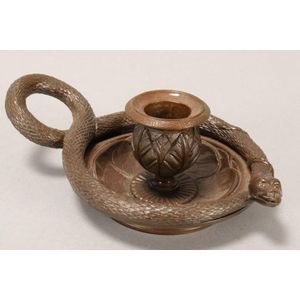Regency serpent candlestick
Regency bronze chamber candlestick, c.1820 of heavy circular form with a finely modelled serpent encircling the rim and coiling to form a loop handle opposite the head, with removable sconce set above a bulbous capital with foliate motifs, raised above a turned circular base, height 5 x length 15.5 cm
You must be a subscriber, and be logged in to view price and dealer details.
Subscribe Now to view actual auction price for this item
When you subscribe, you have the option of setting the currency in which to display prices to $Au, $US, $NZ or Stg.
This item has been sold, and the description, image and price are for reference purposes only.
- Bronze - An alloy of copper and tin, traditionally in the proportions of about 9 parts of copper to 1 part of tin.
The discovery of bronze in Western Asia in the 4th century enabled people to create metal objects which were superior to those previoulsy possible because of its strength and hardness, and it has been used throughout the world for weapons, coins, tools, statuary and other decorative items.
It is very fluid in a molten state, and its hardness, strength when set, and non-corrosive properties makes it most suitable for casting sculpture. - Foliate - Decorated with leaves or leaf-like forms.
- Regency Period - The Regency period in English furniture design refers to the period when King George III, was declared unfit to rule in 1811, and his son ruled as proxy as Prince Regent, until 1820, and then, after the death of his father as George IV until his death in 1830. The Regency period was preceded by the Georgian period (George I, George II, and George III: 1714 - 1811), and was followed by the William IV period, which only lasted until 1837 when William IV died as was succeeded by Queen Victoria.
- Sconce - A light attached to a wall. Originally a candle holder that is attached to a wall with an ornamental bracket and sometimes with a reflective back plate, but now applied to an electric light that has been inspired by that design.
In recent times the word has also come into use to desribe the candle holders on a candelabra. - Capital - In architecture, a capital is the topmost member of a column, pilaster, or pier, which sits on top of the shaft and supports the entablature or architrave above it. The capital is typically the most ornate and decorative element of the column, and it can take many different forms depending on the architectural style of the building.
In classical architecture, the most common types of capitals are the Doric, Ionic, and Corinthian. Doric capitals are simple and have a circular shape with a flat top and bottom. Ionic capitals have a more elaborate design with scrolls or volutes (spiral shapes) at the top, and Corinthian capitals are the most decorative, with elaborate carvings of acanthus leaves and other motifs.
In other architectural styles, capitals can take many different forms, such as the bell-shaped capitals of Gothic architecture or the foliate designs of the Romanesque period. The capital is one of the most important architectural element in a building, it is the one that gives the most character and identity to the building.
This item has been included into following indexes:
-
candlesticks, material
- gilt and bronze 261
- ormolu and bronze 183
- chambersticks - silver, silver plate and brass 126
